Bioprinting, the 3D printing of living tissues, holds immense potential for revolutionizing medicine. From creating transplantable organs to personalized drug testing, advancements in bioprinting are happening at a rapid pace. However, alongside this scientific excitement lie important ethical considerations. This blog post will delve into the top 10 bioprinting breakthroughs, exploring not only the exciting possibilities but also the critical questions we need to address to ensure the responsible and equitable development of this transformative technology.
Also, read: Top 10 Must-Have Gadgets and Tech Gear for 2024
What is bioprinting?
Bioprinting is an additive manufacturing process that builds artificial body parts out of filaments made from living cells. Typically, these biomaterial filaments (called bio-ink) are extruded layer by layer to create a synthetic biomedical part, similar to 3D printing. The idea is to build biomimetic structures that accurately replicate those naturally occurring in our bodies. So far, bioprinting can produce living tissue, bone, and blood vessels, to eventually fabricate entire organs from scratch.
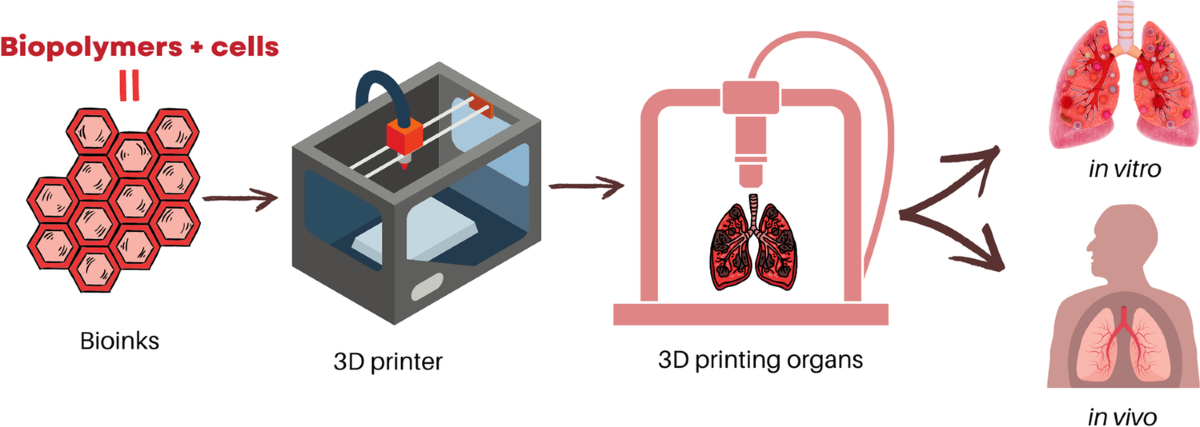
Bioprinting is the process of creating 3D, cellular structures out of bio-inks. It’s used to build functional, biological replicas of body parts, like living tissues, bone and blood vessels.
How does bioprinting work?
Bioprinting borrows the core idea from regular 3D printing, but instead of plastic or metal, it uses bio-inks containing living cells to create 3D structures that mimic natural tissues. Here’s a breakdown of the bioprinting process:
1. Design and Planning: Similar to 3D printing, bioprinting starts with a digital design. Medical imaging techniques like CT scans or MRIs are used to create a detailed 3D model of the desired tissue. This model serves as the blueprint for the bioprinter.
2. Bioink Preparation: Bioink is a key component in bioprinting. It’s a specialized material that combines living cells with a scaffolding material, typically a hydrogel. The hydrogel provides support and structure for the cells to grow and organize themselves. Different bioinks are being developed to accommodate the needs of various tissues.
3. The Printing Process: There are different bioprinting techniques, but all involve depositing the bioink layer-by-layer to build up the 3D structure. Some common methods include:
-
- Extrusion-based bioprinting: This is similar to a regular inkjet printer. The bioink is deposited through a nozzle, like toothpaste from a tube.
- Laser-assisted bioprinting: A laser beam is used to precisely arrange the bioink droplets.
- Inkjet bioprinting is similar to an inkjet printer but uses bioink instead of ink.
4. Post-printing and Cell Culture: Once the printing is complete, the printed structure needs to be cultured in a controlled environment that mimics the natural conditions for the target tissue. This allows the cells to mature and organize themselves into functional tissue.
Also, read; Top 10 Cybersecurity Threats to Businesses in 2024
Printing Life: Top 10 Advances in Bioprinting and its Ethical Considerations
Bioprinting, a burgeoning field at the intersection of biology, engineering, and medicine, holds immense promise for addressing critical healthcare needs. By leveraging cutting-edge technology, researchers have made significant strides in fabricating living tissues and organs, heralding a new era in regenerative medicine. However, as the capabilities of bioprinting continue to expand, so do the ethical dilemmas surrounding its application. In this article, we embark on a journey to explore the top 10 advances in bioprinting and the ethical considerations they evoke.
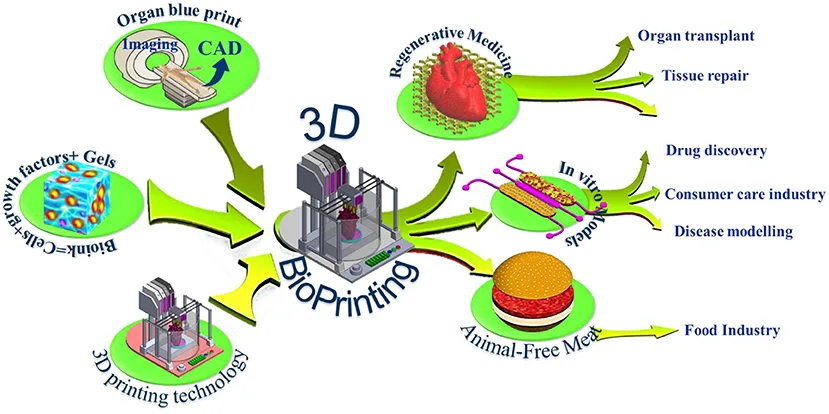
1. Vascularization: Breath of Life for Bioprinted Tissues
One of the biggest hurdles in bioprinting tissues is creating a functional network of blood vessels, known as vascularization. Tissues thicker than a few hundred micrometers struggle to survive without a way to deliver oxygen and nutrients and remove waste products. Bioprinting techniques are addressing this challenge in several ways. One approach utilizes sacrificial bio-inks. These special materials are printed to form a template for the blood vessel network, then dissolved later, leaving behind hollow channels that can be seeded with endothelial cells, the building blocks of blood vessels.
Alternatively, bio-inks can be pre-loaded with these endothelial cells or other cell types that support vessel growth. Additionally, researchers are exploring bio-inks that can respond to biochemical cues, promoting the growth and maturation of blood vessels within the bioprinted construct. Successful vascularization is crucial for engineering complex tissues and organs, paving the way for bioprinting to become a transformative tool in regenerative medicine and drug discovery.
Also, read: Top 10 Emerging Technologies Shaping the Future of Work in 2024
2. Multi-material Bioprinting: Building Mimicry, One Layer at a Time
Traditional bioprinting, while impressive, often struggles to replicate the intricate composition of natural tissues. Here’s where multi-material bioprinting steps in. This revolutionary technique allows for the precise deposition of multiple bioinks, each containing distinct cell types and biomaterials. Imagine printing a bone scaffold with soft, collagen-rich regions for cartilage and stronger, mineralized areas for bone growth—all within the same construct. This level of control is crucial for engineering complex tissues like muscles, which have specific vascular networks and varying cell types throughout.
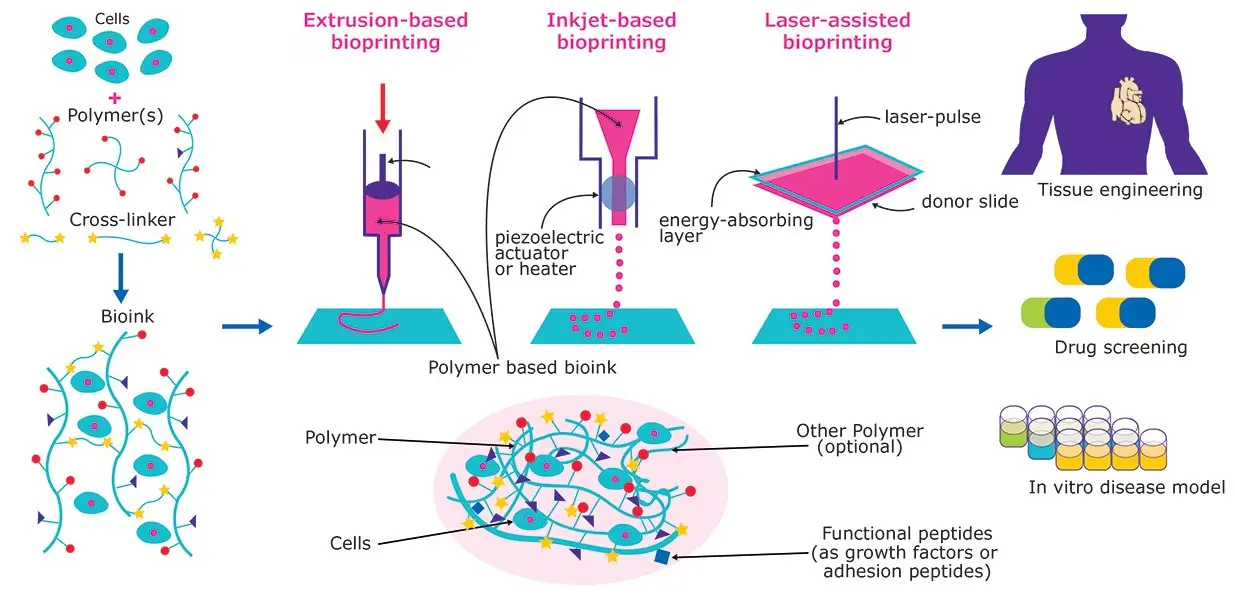
Multi-material bioprinting holds immense promise for creating functional organ units, potentially for transplantation. Researchers are developing bio-inks that mimic the stiffness and degradability of native tissues, allowing for better cell adhesion, growth, and functionality. However, challenges remain. Optimizing bio-ink combinations and ensuring seamless integration between different materials is crucial. Despite these hurdles, multi-material bioprinting is rapidly advancing, paving the way for a future where bioprinted tissues can truly mirror the remarkable complexity of the human body.
3. Bioinks: The Scaffolding of Life in 3D Printing
Bioinks are the lifeblood of bioprinting, acting as the essential ink for this revolutionary technology. These biocompatible materials are much more than just passive holders; they actively support and guide the behavior of encapsulated cells. Bioinks can be formulated from natural materials like collagen or synthetic polymers, and are often designed to mimic the structural and biochemical cues of the target tissue. This allows them to provide essential signals for cell adhesion, proliferation, and differentiation, influencing how the cells grow and organize within the printed construct.
The ideal bioink should possess printability for precise deposition, biocompatibility to avoid harming the cells, and biodegradability to allow the cells to take over and form functional tissue. Research on bio-inks is ongoing, focusing on creating advanced formulations that can integrate multiple cell types, vascularization networks, and properties that match the complexity of various tissues. These advancements in bioink design are paving the way for the creation of more sophisticated and functional bioprinted tissues and organs, bringing us closer to the future of regenerative medicine.
Also, read: Top 10 Search Engines In The World (2024)
4. 3D Bioprinting with Stem Cells: A Regenerative Revolution
3D bioprinting with stem cells holds immense promise for regenerative medicine. Stem cells, with their unique ability to differentiate into various specialized cell types, become the building blocks for bioprinted tissues. By incorporating stem cells into bioinks, scientists can create complex structures that mimic natural tissues, potentially offering solutions for organ transplantation, disease modeling, and drug discovery. Advancements in bio-ink development allow researchers to tailor the materials to specific cell needs, promoting cell survival, growth, and differentiation within the printed construct.
This technology has already shown success in printing skin, bones, and even rudimentary blood vessels. However, challenges remain. Bioprinting needs to overcome limitations in replicating the intricate vascular networks essential for thicker tissues and organs. Additionally, ensuring the long-term functionality and maturation of bioprinted tissues requires further research. Despite these hurdles, 3D bioprinting with stem cells paves the way for a future where personalized medicine can replace damaged tissues and organs, offering a new era of regenerative healthcare.
5. 4D Bioprinting: Redefining Tissue with Time
While 3D bioprinting creates static structures, 4D bioprinting introduces the exciting concept of time. These bioprinted constructs are designed to transform or self-assemble after printing in response to external cues like light, temperature, or electrical signals. Imagine a bioprinted heart stent that folds for minimally invasive surgery and then unfolds within the body to assume its final shape. 4D bioprinting holds immense potential for creating tissues that better mimic natural development and function.
By incorporating stimulus-responsive biomaterials and cells, scientists can engineer tissues that remodel and mature over time, potentially leading to more functional implants and improved drug testing platforms. However, challenges remain in precisely controlling the self-assembly process and ensuring the long-term viability and functionality of the bioprinted cells within the 4D construct. Despite these hurdles, 4D bioprinting represents a revolutionary frontier in fabrication, offering a glimpse into the future of regenerative medicine and artificial tissues.
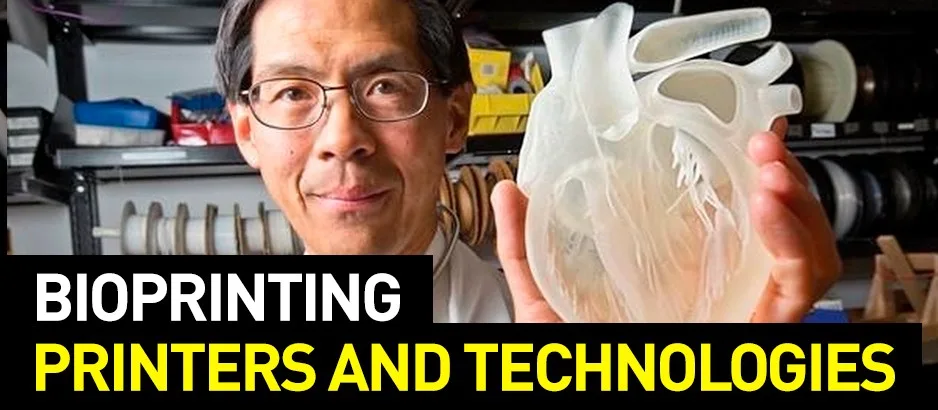
Also, read: Top 10 Spread Betting Platforms to Power Your Trades in 2024
6. High-resolution bioprinting: Sculpting life in microscopic detail
High-resolution bioprinting is revolutionizing the ability to create intricate tissue structures with feature sizes down to microns, mimicking the delicate organization of natural tissues like nerves and blood vessels. This level of detail is crucial for engineering functional tissues. One key technique for achieving this is two-photon polymerization, which uses a focused laser to cure bio-inks with exceptional precision. This allows scientists to print complex microchannels within the bioprinted construct, essential for transporting nutrients and oxygen to keep cells alive within thicker tissues. The ability to precisely arrange different cell types within these high-resolution structures is another exciting advancement.
This holds immense promise for bioprinting tissues that require specific spatial organization, like the intricate layering of cells found in the heart or the highly structured organization of the brain. However, achieving both high resolution and high cell density remains a challenge. Nevertheless, high-resolution bioprinting is a rapidly growing field with the potential to unlock a new era of bioprinting for engineering complex and functional tissues for transplants, drug discovery, and personalized medicine.
7. Organ Printing: Printing the Future of Transplants?
Organ printing holds immense promise for revolutionizing organ transplantation. By utilizing bioprinting techniques, scientists aim to create functional organ units capable of mimicking the structure and function of natural organs like hearts, kidneys, and livers. This could significantly address the critical shortage of donor organs, offering hope to countless patients waiting for life-saving transplants.
Advancements in bioink development allow researchers to incorporate living cells and biocompatible materials to create complex 3D structures. One of the major challenges lies in creating a network of blood vessels within the printed organ, crucial for oxygen and nutrient delivery. However, progress is being made in vascularization techniques, paving the way for fully functional organs.

The potential benefits of organ printing extend beyond transplantation. Bioprinted tissues can serve as highly accurate models for drug discovery, allowing for personalized medicine by using a patient’s cells to test drug efficacy and predict potential side effects. While significant hurdles remain, organ printing offers a glimpse into the future of regenerative medicine, which has the potential to transform healthcare and save countless lives.
Also, read: Top 10 Sports Betting Apps in 2024
8. Bioprinting for Drug Discovery: Revolutionizing the Testing Landscape
Bioprinting is revolutionizing drug discovery by offering a new generation of 3D human tissue models. Unlike traditional flat cell cultures, bioprinted tissues mimic the complex structure and cellular organization of real organs. This allows for more accurate testing of drug efficacy and toxicity. Researchers can now observe how drugs interact with multiple cell types within a tissue, providing a more realistic picture of how a drug might behave in the human body. Additionally, bioprinting opens doors for personalized medicine.
By using a patient’s cells to bio-print tissues, scientists can test drugs for effectiveness on an individual basis, paving the way for targeted therapies with fewer side effects. This technology has the potential to streamline drug development, reduce animal testing, and ultimately deliver life-saving treatments to patients faster. However, challenges remain. Developing bio-inks that perfectly mimic various tissues and incorporating functional blood vessels are areas of ongoing research. Nevertheless, bioprinting for drug discovery holds immense promise for the future of medicine.
9. Bioprinting for Personalized Medicine: A New Era of Tailored Treatments
Bioprinting holds immense promise for personalized medicine, revolutionizing how we treat patients. Imagine using a patient’s cells to create bioprinted tissues that perfectly match their biology. This could address organ donor shortages by creating transplantable tissues for heart disease, kidney failure, or even burns. Bioprinting could also be used to create personalized disease models, allowing doctors to test potential treatments on a patient’s specific tissue before administering them. This personalized approach has the potential to improve treatment efficacy, reduce side effects, and accelerate drug discovery.
However, challenges remain. Ethical considerations regarding informed consent and ownership of bioprinted tissues need to be addressed. Additionally, bioprinting complex tissues with functional blood vessels is an ongoing area of research. Despite these hurdles, bioprinting for personalized medicine offers a glimpse into a future where treatments are tailored to each patient’s unique needs.
Also, read: Top 10 Must-Have Gadgets for the Tech-Obsessed American in 2024
10. Automation and Robotics: The Engines of Efficiency in Bioprinting
Traditionally, bioprinting required extensive human involvement, making it a meticulous process. However, automation and robotics are transforming this field, offering solutions for increased throughput, precision, and consistency. Robotic arms, programmed for complex printing paths, enable the creation of intricate structures and facilitate multi-material bioprinting with high accuracy. This is particularly beneficial for in-situ bioprinting, where tissues are directly printed within the body.
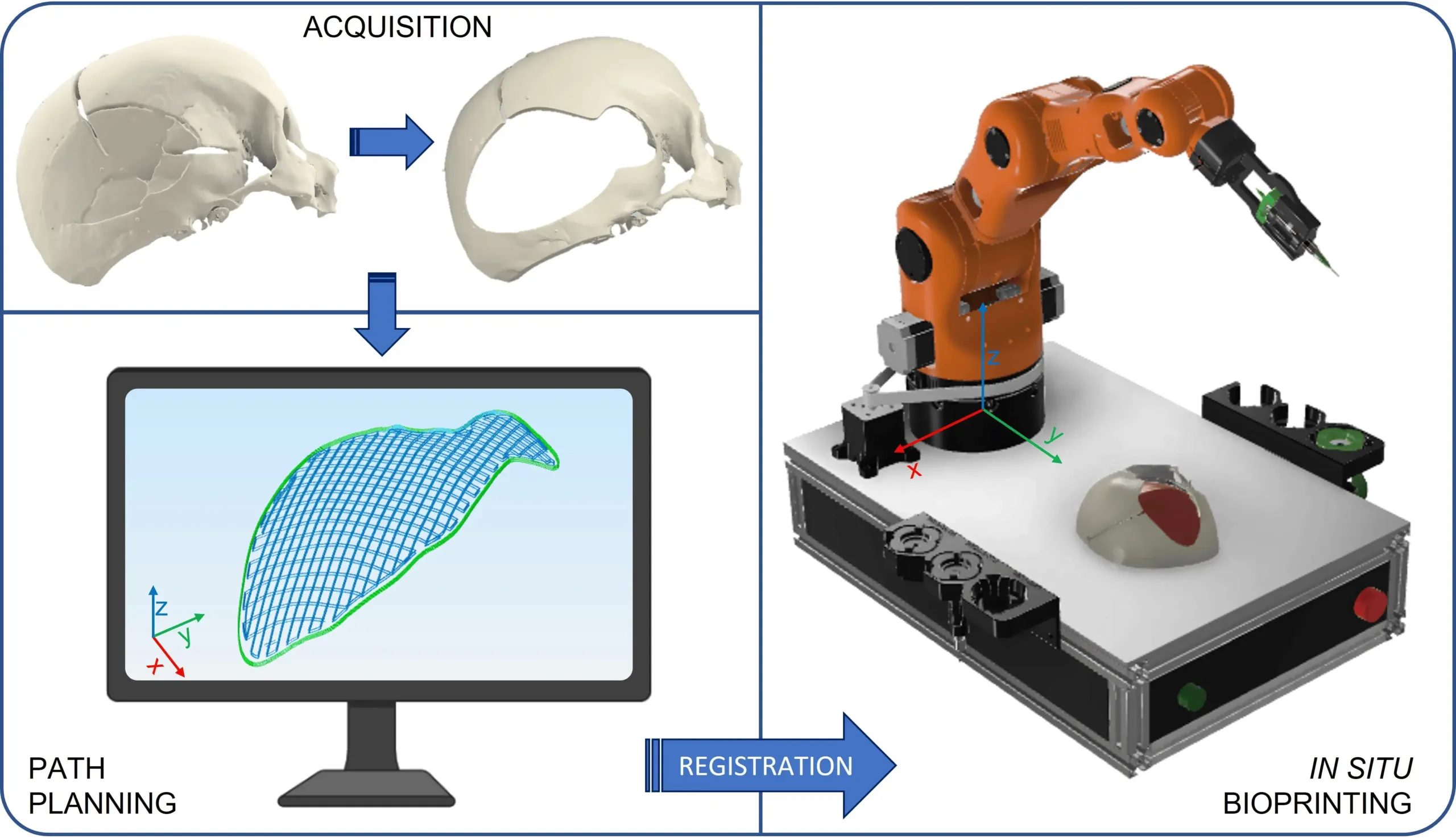
Moreover, automation streamlines tasks such as bioink preparation, cell loading, and post-printing processes, allowing researchers and clinicians to focus on other critical aspects. The integration of robotics holds great promise for large-scale bioprinting in tissue engineering and regenerative medicine. Nevertheless, challenges persist in developing flexible and adaptable robotic systems capable of handling the delicate nature of biomaterials and cells. Additionally, robust software and control systems are essential for precise bioprinting and seamless integration with the design and planning stages. As automation and robotics continue to advance, they will undoubtedly drive bioprinting toward becoming a more standardized and efficient technology for creating complex tissues and organs.
Ethical Considerations in Bioprinting
The ethics of bioprinting is a sub-field of ethics concerning bioprinting. Some of the ethical issues surrounding bioprinting include equal access to treatment, clinical safety complications, and the enhancement of the human body (Dodds 2015).
Ethical considerations in research are a set of principles that guide your research designs and practices. These principles include voluntary participation, informed consent, anonymity, confidentiality, potential for harm, and results-based communication. Scientists and researchers must always adhere to a certain code of conduct when collecting data from people. These considerations protect the rights of research participants, enhance research validity, and maintain scientific integrity.
The goals of human research often include understanding real-life phenomena, studying effective treatments, investigating behaviors, and improving lives in other ways. What you decide to research and how you conduct that research involve key ethical considerations. Some ethical consideration issues are given below:–
Also, read: Top 10 Best Pet Sitting Apps in 2024
- Informed consent: Bioprinting, especially personalized medicine applications using a patient’s cells, raises new challenges for informed consent. Patients need a clear understanding of how their cells will be used, the potential risks and benefits of bioprinted tissues, and their right to withdraw consent at any stage.
- Ownership and patenting: Bioprinting raises questions about who owns bioprinted tissues, especially those made with a patient’s cells. Additionally, there are debates on patenting bioprinting techniques and bioinks. Balanced commercial incentives for innovation with equitable access to this technology is crucial.
- Resource allocation: Bioprinting holds immense potential for regenerative medicine, but ensuring equitable access is crucial. Without proper resource allocation, this technology could exacerbate healthcare disparities, leaving those in underprivileged communities without access to these life-saving advancements.
- Weaponization: Bioprinting’s potential for good is undeniable, but its ability to create custom biological materials raises concerns about weaponization. Malicious actors could engineer harmful pathogens or toxins using bioprinting, making it crucial to establish international regulations and control measures to prevent bioprinting technology from falling into the wrong hands.
- Chimera and human germline editing: Bioprinting techniques raise concerns about creating human-animal chimeras or using bioprinted tissues for germline editing. This could introduce unintended consequences and ethical dilemmas, requiring careful consideration before these applications are explored.
- Psychological impact: Bioprinting holds immense promise for organ transplants and body part replacements, but the psychological impact on recipients cannot be overlooked. Imagine the mental and emotional challenges of receiving a bioprinted heart or a new limb. Carefully considering a patient’s readiness and providing robust psychological support will be crucial for successful adaptation to a bioprinted body.
- Social justice: Bioprinting holds immense promise for healthcare, but unequal access to this technology could exacerbate existing health disparities. We must address affordability, ensure research focuses on diseases affecting underserved communities, and develop frameworks to prevent bioprinting from widening the gap in healthcare equity.
- Environmental impact: Bioprinting’s sustainability needs addressing. Bioinks and printing processes can generate waste. Focusing on biocompatible and biodegradable materials, as well as minimizing energy use during printing, are crucial steps toward a greener bioprinting future.
- Regulation and oversight: Bioprinting’s potential necessitates clear regulations to ensure patient safety and ethical practices. Oversight bodies must be established to monitor research, standardize bioink and bioprinting protocols, and address concerns like informed consent and equitable access to this transformative technology.
- Public discourse: Open discussions about bioprinting’s ethical implications are crucial. Engaging the public through forums, educational campaigns, and media outreach can ensure informed decision-making about the development and use of this powerful technology.
Also, read: Top 10 Benefits of Vertical Farming
FAQs: Advances in Bioprinting and its Ethical Considerations
Q: Can bioprinting create organs for transplant?
Bioprinting organs is a promising area of research, with progress towards functional organ units. However, creating fully functional, transplantable organs remains a challenge.
Q: How is bioprinting used in medicine besides transplants?
Bioprinting is used for creating 3D human tissue models for drug testing, personalized medicine approaches, and studying disease development.
Q: Is bioprinting with stem cells safe?
While stem cells hold immense potential, there are safety concerns regarding potential tumor formation and immune rejection in bioprinted tissues using stem cells.
Q: What are the limitations of bioprinting?
Current limitations include replicating the complex vascular networks of organs and ensuring the long-term functionality of bioprinted tissues.
Also, read: Top 10 Best Data Science Tools for Businesses
Q: Who owns a bioprinted organ made with a patient’s cells?
Ownership of bioprinted tissues, especially those using a patient’s cells, is a complex legal issue with ongoing debate.
Q: Could bioprinting be used to create designer babies?
Ethical concerns surround the potential use of bioprinting technologies for human germline editing, which could have unintended consequences.
Q: Will bioprinting be affordable for everyone?
Ensuring equitable access to bioprinting technologies for healthcare applications is crucial to avoiding widening healthcare disparities.
Also, read: Top 10 Tips for Implementing a Cybersecurity Mesh Architecture
Q: What regulations are in place for bioprinting?
Regulations for bioprinting research and applications are still evolving. Establishing clear guidelines is essential for responsible development.
Q: Should we be worried about bioprinting being used for weapons?
Bioprinting has the potential to be misused. International collaboration and clear regulations are needed to prevent weaponization.
Q: How can the public stay informed about bioprinting advancements?
Open communication and public discourse are essential. Scientific institutions and media outlets have a role to play in educating the public about bioprinting’s potential and ethical considerations.
Conclusion: The Final Words
Bioprinting, a groundbreaking technology that has the potential to revolutionize healthcare and other industries, has witnessed significant advancements in recent years. From the creation of functional tissues and organs to the development of personalized medicine, bioprinting has demonstrated its immense capabilities. However, as with any emerging technology, ethical considerations must be carefully addressed to ensure its responsible and beneficial use.
In conclusion, the top 10 advances in bioprinting represent a paradigm shift in healthcare, offering transformative solutions to pressing medical challenges. From fabricating personalized organs to modeling complex tissues, bioprinting holds the promise of revolutionizing regenerative medicine. However, as we marvel at the possibilities of bioprinting, it is imperative to acknowledge and address the ethical considerations that accompany these advancements. By fostering interdisciplinary dialogue and ethical reflection, we can ensure that bioprinting continues to advance human health while upholding principles of justice, autonomy, and beneficence.


































